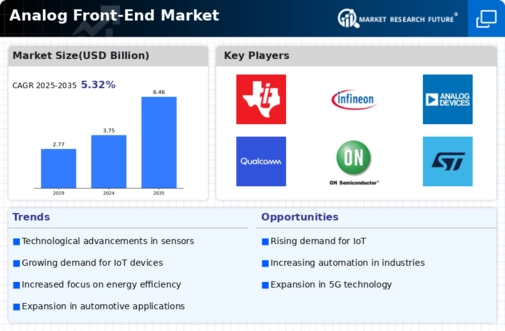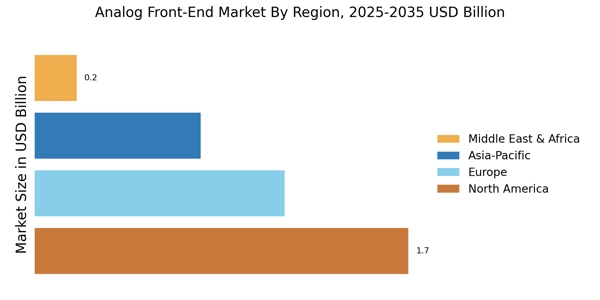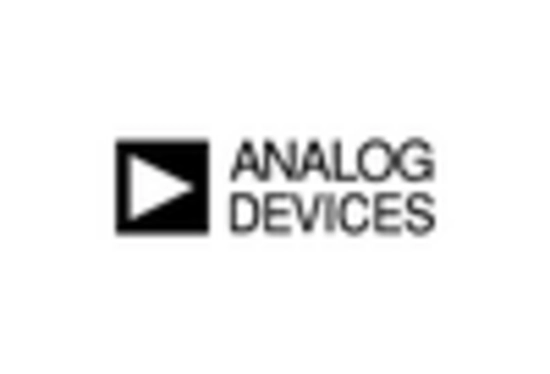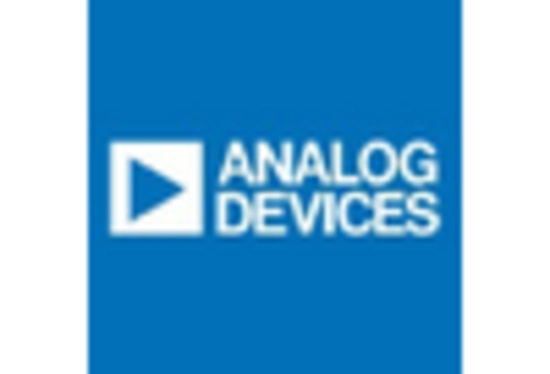Emergence of Smart Cities
The development of smart cities is a pivotal factor influencing the Analog Front-End Market. As urban areas increasingly adopt smart technologies for infrastructure management, transportation, and energy efficiency, the demand for sophisticated analog front-end solutions rises. In 2025, investments in smart city initiatives are expected to reach over 1 trillion USD, creating a substantial market for analog front-end components. These components are essential for the integration of sensors and communication systems that facilitate real-time data collection and analysis. Consequently, the Analog Front-End Market stands to benefit from the growing emphasis on smart city projects, which require reliable and efficient analog solutions.
Rising Demand for IoT Devices
The proliferation of Internet of Things (IoT) devices is a primary driver for the Analog Front-End Market. As more devices become interconnected, the need for efficient analog front-end solutions increases. In 2025, the number of IoT devices is projected to surpass 30 billion, necessitating advanced analog front-end components to manage data acquisition and signal processing. This surge in demand is likely to propel the growth of the Analog Front-End Market, as manufacturers seek to enhance device performance and reliability. Furthermore, the integration of analog front-end solutions in IoT applications can lead to improved energy efficiency and reduced operational costs, making them attractive to developers and consumers alike.
Growth of Automotive Electronics
The automotive sector is undergoing a transformation, with an increasing reliance on electronic systems for safety, navigation, and entertainment. This trend is a significant driver for the Analog Front-End Market. By 2025, the automotive electronics market is projected to exceed 400 billion USD, with a substantial portion dedicated to analog front-end components. These components play a crucial role in processing signals from various sensors and systems within vehicles, ensuring optimal performance and safety. As electric and autonomous vehicles gain traction, the demand for advanced analog front-end solutions is likely to escalate, further propelling the growth of the Analog Front-End Market.
Increased Focus on Renewable Energy
The shift towards renewable energy sources is a significant driver for the Analog Front-End Market. As countries strive to reduce carbon emissions and enhance energy sustainability, the demand for renewable energy technologies, such as solar and wind power, is on the rise. In 2025, the renewable energy market is projected to surpass 2 trillion USD, with a notable requirement for analog front-end components in energy management systems. These components are vital for monitoring and controlling energy production and consumption, ensuring optimal performance and efficiency. The Analog Front-End Market is likely to experience growth as the transition to renewable energy accelerates, necessitating advanced analog solutions for effective energy management.
Advancements in Healthcare Technology
The Analog Front-End Market is significantly influenced by advancements in healthcare technology. The increasing adoption of medical devices, such as wearable health monitors and diagnostic equipment, drives the demand for high-performance analog front-end solutions. In 2025, the global market for medical devices is expected to reach approximately 500 billion USD, with a substantial portion attributed to devices requiring sophisticated analog front-end components. These components are essential for accurate signal processing and data conversion in medical applications, thereby enhancing patient care and monitoring capabilities. As healthcare technology continues to evolve, the Analog Front-End Market is poised for growth, driven by the need for innovative and reliable solutions.
















Leave a Comment